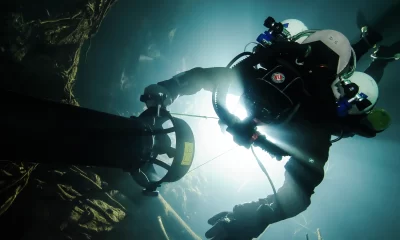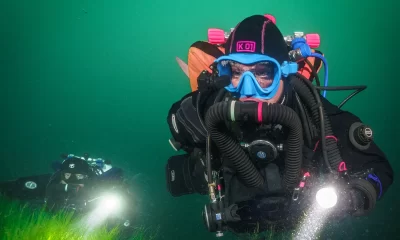Equipment
Heads Up Swimmers and Divers Who Swim
Wouldn’t it be great to have your essential swim metrics right in front of your face, so you wouldn’t have to slow down to steal a glance at the clock, or flick a wrist and read your swim watch? Now you can! (Never mind that agencies only require you to paddle 300-400m at a jellyfish pace—you do keep up your swimming don’t you??) Here InD exec editor Michael Menduno, a passionate swimmer, reviews the latest in performance swimming technology. Can diving be far behind?

By Michael Menduno
I am a water person. I swim four to five days a week. I am a diver. I’m also a technologist and gearhead. So, when I saw the FORM ‘smart’ (augmented reality) swim goggles, I knew I had to try a pair.
FORM goggles offer the swimmer key user selectable metrics such as time elapsed; distance swam, split times, interval times, pace per 50/100 yards or meters, stroke rate/SWOLF, or even calories burned in a concise, bright-yellow heads up display that appears to float in your field of vision. Note that the metrics are based on the trailing length; they’re not instantaneous. The heads up display also cleverly sequences metrics as the swim progresses. For example, it shows the new split time after the swimmer performs their turn. Also, the eyepieces are symmetric so that display can be positioned in either your right or left eye.
As a result, you don’t have to stop swimming to look at your swim watch or deck clock for timing, and it counts your laps in case your early morning swim brain loses track. According to the company, the goggles free up your mental bandwidth so you can focus on your form, hence the name. Did I mention they currently have no competition?

FORM goggles can be readily set for lap swimming, intervals or drills (ah those kick sets!) with the two tiny toggle buttons on the side of the goggles; they don’t have GPS and so don’t work for open water swims. At the end of your workout, you save the swim using the menu buttons, and it’s uploaded to the companion app on your smartphone via Bluetooth, where it is stored and can be shared. Your swim data can also be uploaded to Strava or Training Peaks, though currently FORM is not integrated with Swim.com, which partners with the U.S. Masters Swimming (USMS) log. That’s where I upload my Apple watch swim data.
Oh, and the goggles also talk to the Polar OH1 optical heart rate sensor, which can be fitted to the google straps, allowing the device to display your heart rate in real time. They can also upload heart data from a Garmin watch. All in all, FORM can only be described as a remarkable piece of engineering.
Interestingly, when I first called the Vancouver B.C. Canada-based company to inquire about their goggles, one of my first questions was, “Are you also planning to offer an augmented reality diving mask?” NOT!
FORM’s marketing director explained to me that there are an estimated 30 million swimmers in the U.S. and 240 million globally making it the largest sport in the world—roughly one to two orders of magnitude larger than diving, including both free and compressed gas divers—and that’s who they plan to focus on. That of course would include triathletes and Iron-people who swim too.
I also realize now that FORM’s secret sauce is a lot more than simply displaying computer data on an in-mask optics display. Though the diminutive optics screen, which is about the size of a 64GB SanDisk card, and the small thumb drive-sized computer positioned at the temples, could easily be incorporated in a diving mask. Shearwater and Thalatoo take note.
The Ghost In The Machine
FORM is the brainchild of 44-year old competitor swimmer cum mechanical engineer, Dan Eisenhardt. He first conceived of the idea for smart swim goggles for his MBA project in 2006, but the available technology, particularly the state of machine learning (ML), at that time made it infeasible. Instead, he and his colleagues created a heads-up display ski mask and went on to form a venture-funded start-up called Recon Instruments, which Eisenhardt incorporated in 2008. He eventually sold the company to Intel in 2015, after creating five generations of smart glass products. He left Intel in late 2016 to return to his original vision, creating a smart swim goggle.

Compared to a swim watch, which is attached to a single ‘stroking’ appendage; detecting starts and stops and strokes—not the Irvine kind (inside joke)—from a device positioned on your head is arguably a harder problem. But FORM appears to handle it with aplomb. Eisenhardt told me that they want to be accurate to within 99% of the metrics and it’s rare to see a mistake. Interestingly the goggles were able to correctly detect my stroke (fly), when my Apple watch didn’t. More on that later.
At the heart of the goggles, is a three-axis accelerometer and a three-axis gyro that interprets what’s going on in the rest of the body i.e. doing freestyle, doing fly, cranking out 80 or 115 strokes a minute, burning calories, based on that sensor input. That’s where machine learning comes in. FORM trained its algorithms using machine learning, with actual data feeds from many different types of swimmers, including the award-winning University of British Columbia’s Thunderbirds swim team, who were all recorded with video cameras. The various types of movements were labeled and then fed back into the algorithms, which were then tweaked and tested again, etc. Rinse and repeat!
Eisenhardt compared machine learning to opening up a Pandora’s box. “We had no idea back then how hard it would be,” he said. “We would change something over here and it would get better, but then something over there would break. It was always a moving target so we had to find an optimum point based on our goals and objectives. That was a big one!”
Other challenges? “It ends up being a combination of things, a kind of an engineering matrix,” Eisenhardt explained. “Low-power optics, machine learning, and bulk; those were three massive constraints, above and beyond price. Because price, is actually the most important. You have to constantly have that price rationale in the background.”
FORM goggles retail for US$199. By comparison, ordinary swim goggles sell for US$15-30 up to US$59 for my MAGIC5 custom-fit goggles. Of course, like many of my swimmates, I have accumulated quite a collection of goggles over time.

My Experience
I found downloading and setting up the FORM app and goggles was easy. The goggles are high quality with a soft sleeve and come with a selection of different sized nose bridges for an optimal fit. I found them very comfortable and watertight, and they didn’t fog. Though they weigh about twice that of an ordinary pair of swim goggles: 2.3 ounces/65 grams compared to about 1.3-1.5 oz/37-43 g, I didn’t notice any difference once they were on my face.

My first experience using the goggles in an outside pool was disappointing. While the heads up display and metrics, which I had positioned in my right eye, were brilliant, I had a hard time seeing out of my left eye. FORM’s lenses are barrel-shaped with a flat forward surface. For me, it looks like a sunglass lens in the middle of my field of view. What’s more is that I kept seeing what looked like cavitation bubbles along the flat surface. As a result, I felt like I couldn’t see the pool well. My view also looked a bit wonky when I approached the wall to turn. FORM says the goggles take a little getting used to. Yup! I tested them in two different outdoor pools with the same result.
I asked Eisenhardt about seeing cavitation bubbles. He said that only two other people out of hundreds or more reported this problem, both of them in outside pools; something about the light perhaps. So I tested them again in an indoor pool. This was my fourth workout session with the goggles. The sunglass effect was definitely diminished, and though I still saw some cavitation bubbles against the glass, my visibility had improved, though not as good as my MAGIC5, which of course, does not include a heads up display. This made me think that with time my vision and or brain would adjust.

I mentioned discovering that the FORM goggles correctly identified my butterfly while my Apple Watch 4 did not. This is often a problem with the watch. It also has trouble identifying breaststroke. Even more interesting, when I compared my split times from my watch on swim.com to those of FORM (I was wearing devices during my trials), the times showed significant differences sometimes amounting to a few seconds. A little unnerving! How fast do I really swim?
This, of course, raises the question, “How accurate is the [name of device]?” The answer of course is, “Compared to what?” It would be useful to compare both to an electronic pad used in swimming comps.
I was already aware of timing problems with the watch. For example, ending a lap by touching with my [left] watch hand yields a different time than touching with my right. Eisenhardt said that FORM’s accuracy is based on matching swim data to video recordings to within a certain tolerance, which is how they derive their 99% accuracy figure. “It’s very rare that you would touch the wall and get a time where you’re like, oh, that doesn’t seem like the right time. It’s just a very rare event. It’s hard to say exactly how accurate we are, but we are definitely accurate enough for you to never have to second-guess a metric.”
So there you have it. I LOVE the FORM display and the data; however, I am not yet happy with the visibility. I wish it integrated with the Swim.com cloud and consequently my official USMS log. ;-( I am also now intrigued with interval and split times, and plan to do more investigation with both devices. Are the FORM goggles worth $199? Never mind how much I’ve already invested in swim goggles, does the money really matter for a sport one feels passionate about? I am going to keep swimming with FORM, and keep my watch on, for now.
Heads up people. Watch this space.
Dive Deeper (from FORM)
https://www.youtube.com/c/formswim

Michael Menduno is InDepth’s executive editor and, an award-winning reporter and technologist who has written about diving and diving technology for 30 years. He coined the term “technical diving.” His magazine “aquaCORPS: The Journal for Technical Diving”(1990-1996), helped usher tech diving into mainstream sports diving. He also produced the first Tek, EUROTek, and ASIATek conferences, and organized Rebreather Forums 1.0 and 2.0. Michael received the OZTEKMedia Excellence Award in 2011, the EUROTek Lifetime Achievement Award in 2012, and the TEKDive USA Media Award in 2018.





















































